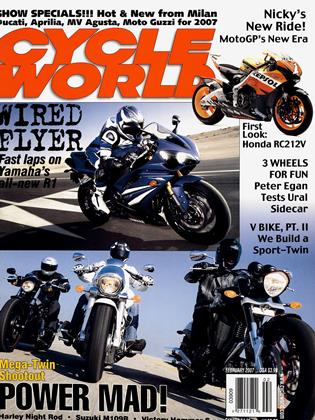Yamaha returns to AMA Superbike
Electronic Racer
The mad scramble to be ready for Daytona isn’t limited to low-bucks privateers. Yamaha’s decision to go AMA Superbike racing in 2007 had to contend with the Mid-Ohio national, added at the end of the ’06 calendar, and two weeks later new YZF-R1 s had to be on the truck for the team’s first Daytona test. Madness!
His voice showing understandable fatigue, Yamaha race chief Tom Halverson described, “...making sure parts were here when we needed them. Suspension and wheels came on time. We had to get machinists to do link ratios, fork clamps...and then make it all fit. Yamaha Italy was a source for a baseline from World Superbike. We have the FaroArm and Computrack here (precise, computer-based alignment tools). This is the first time we’ve put bikes together from scratch in a while. We had measurements for seat height and bar and peg locations, so we didn’t have to do any of that at the last minute. But when we got to Daytona, they ran, they didn’t wobble, and they (riders Eric Bostrom and Jason DiSalvo) turned in some really decent lap times.
Suspension was very good.
This was with pretty much a Superstock engine spec but, even so, top speeds weren’t far off. It was pretty gratifying, really.”
Superstock spec means everything stock save for precision assembly, cam phasing and a blend or other high-quality valve seat treatment.
Yamaha’s 10OOcc Superstock racebikes have in the past run in the 190-mph range at Daytona.
Yamaha’s Marelli enginemanagement engineer Stefano Perotta said, “There is a long way to go because there are things still under development.” He was
unable to provide details because clearly Halverson was holding the Bible when Perotta was sworn to secrecy.
“The rider is such a big part of the dynamics,” Perotta did offer. “He must adjust the electronic systems to suit his riding style but may also adjust a little bit his style to them. It is definitely a two-way process.”
Assistant race chief Keith McCarty, a gravel-voiced veteran of many years in motocross and roadracing, summed up by saying, “I’m confident we’ll be in the game,”
Why did Yamaha leave Superbike, and why is it back now? “The rules AMA wanted weren’t consensus-based and put Yamaha at a disadvantage,” answers McCarty. “We wanted to be in Superbike but with a chance to win, not just to be there.”
Now, clearly, having the new YZF-R1 with its electronic throttle, variable intake length and other features puts success within reach. Since the October Daytona test, they have run a second test in Northern California, and there’ll be another couple of tests before they go to Daytona in March.
McCarty echoed Perotta by saying, “We don’t (yet) have every part that we’re going to have.”
Recent AMA Superbike seasons have been largely Suzukidominated, and fans have yearned for a wider war. They may get it. Yamaha, with its new R1 production bike now so conceptually similar to its proven MotoGP YZR-M1, is in a good position to get double value from its Grand Prix technologies. Kevin Cameron
 View Full Issue
View Full Issue
More From This Issue
-
 Up Front
Up FrontBike of the Year, 2006
FEBRUARY 2007 By David Edwards -
 Leanings
LeaningsFlying On the Ground
FEBRUARY 2007 By Peter Egan -
 TDC
TDCMixing It
FEBRUARY 2007 By Kevin Cameron -
 Departments
DepartmentsHotshots
FEBRUARY 2007 -
 Roundup
RoundupItaly Rocks!
FEBRUARY 2007 By Bruno De Prato -
 Roundup
RoundupTen-Nine-Eight...Wow!
FEBRUARY 2007 By Bruno De Prato







